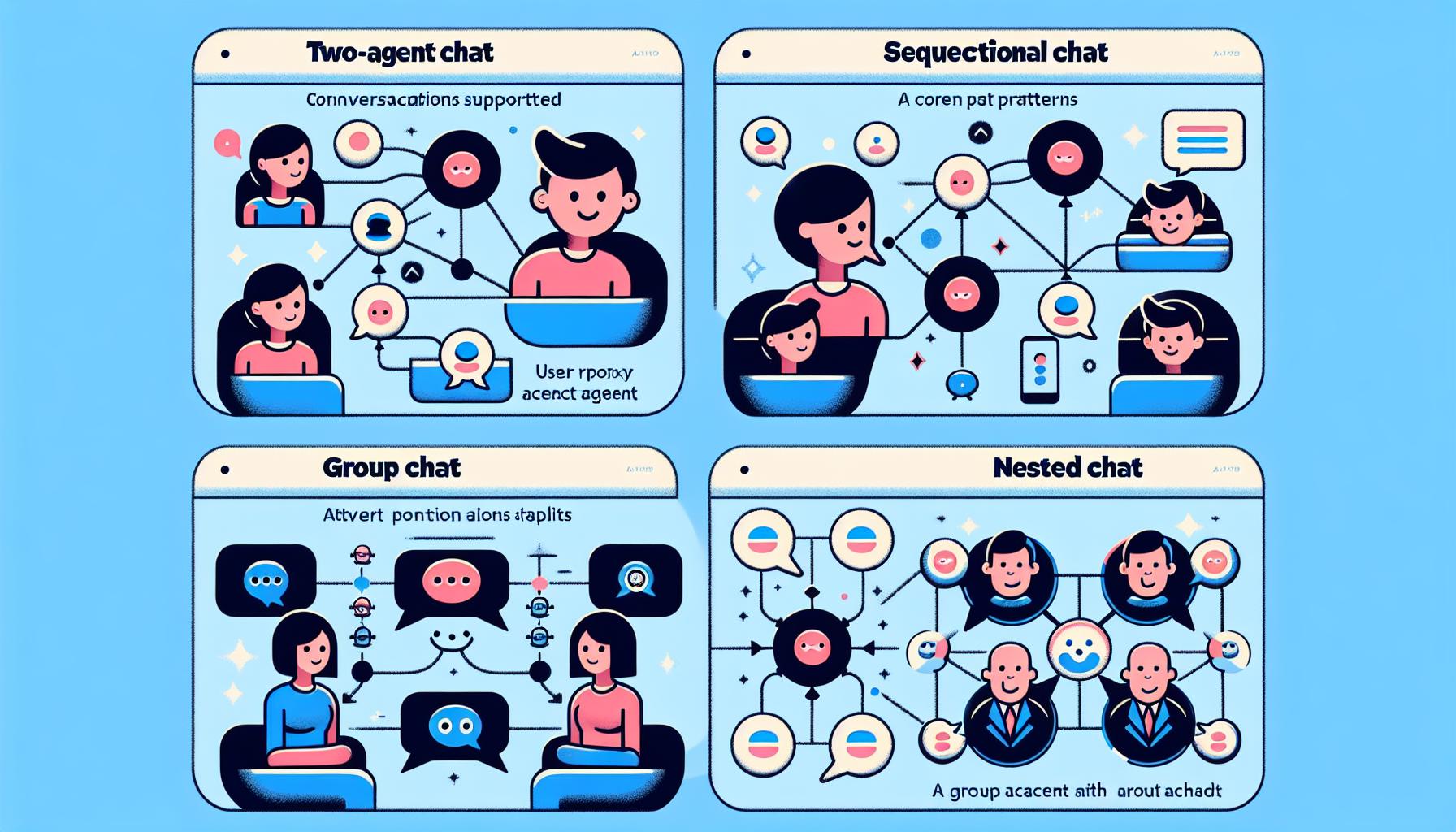Understanding AutoGen Conversation Patterns for AI Agents

Introduction
The evolution of A.I. technology has brought forth an array of advanced tools designed to streamline and enhance communication between agents. AutoGen stands out in this field, offering an efficient framework to facilitate various conversation patterns for A.I. agents. From solving customer queries to conducting complex multi-agent transactions, AutoGen provides numerous patterns such as Two-Agent Chat, Sequential Chat, Group Chat, and Nested Chat. Through these conversation patterns, A.I. agents can efficiently tackle varied problems, simplifying complex workflows.
Pattern 1: Two-Agent Chat
The Two-Agent Chat pattern is the simplest and most straightforward form of interaction in AutoGen. It typically involves a UserProxyAgent and an AssistantAgent. This setup is ideal for basic interactions, such as customer support, where one agent responds to a user's query.
In this pattern, the user_proxy sends a message to the specialist, initiating a communication that can be easily summarized at the end of the conversation. The simplicity of this pattern makes it particularly useful for quick and straightforward interactions where complex decision-making is not required.
Pattern 2: Sequential Chat
The Sequential Chat pattern is designed for scenarios where tasks need to occur in a specific order. This pattern ensures that the conversation context is carried over from one agent to the next until a solution is found. This is particularly useful for workflows that require a step-by-step approach, ensuring that each agent interaction builds upon the previous one.
In a typical sequential chat scenario, the user_proxy initially communicates with a specialist. Following their interaction, the user_proxy then communicates with a surveyor to gather feedback. This sequence allows for a coherent flow of information and ensures that all necessary steps are followed in the conversation.
Pattern 3: Group Chat
Group Chat is a more complex conversation pattern where multiple agents interact within a managed structure to collaborate on tasks. This interaction is overseen by a Group Chat Manager, which orchestrates the flow of conversation by selecting which agent speaks next. The Group Chat Manager employs various strategies, such as auto, manual, random, or round-robin, to determine the speaking order of agents.
This pattern is especially useful for collaborative tasks that require input and coordination from multiple agents. The Group Chat Manager ensures structured and efficient communication among agents, thereby enhancing the overall effectiveness of the interaction.
Pattern 4: Nested Chat
Nested Chats introduce another layer of complexity by involving side conversations within the main discussion. These side conversations are triggered by specific conditions, allowing for specialized interactions without the primary user being aware. This pattern is particularly useful for handling specialized queries that require consultation with a Knowledge Base Manager (kb_manager) or other specialized agents.
In a typical nested chat scenario, a specialist may initiate a nested chat with a kb_manager based on certain trigger conditions, such as the detection of specific keywords. This allows the specialist to seek additional information or guidance without interrupting the primary conversation.
Conclusion
AutoGen provides a versatile framework for optimizing A.I. agent interactions through a variety of conversation patterns. By experimenting with these patterns, developers can tailor their applications to meet specific needs, while being mindful of potential costs associated with frequent and extensive A.I. interactions. Understanding and implementing the right conversation patterns can significantly enhance the efficiency and effectiveness of AI-driven communication.
Questions and Answers
1. How does AutoGen ensure efficient communication when more than two agents are involved?
AutoGen ensures efficient communication in multi-agent scenarios through the use of a Group Chat Manager. This manager orchestrates the flow of conversation by selecting the next speaking agent based on various strategies, such as auto, manual, random, or round-robin. This structured approach ensures that each agent has a chance to contribute in an organized and efficient manner.
2. What strategies can the Group Chat Manager use to select the next speaking agent?
The Group Chat Manager in AutoGen can utilize several strategies to determine the next speaking agent. These strategies include:
- Auto: Automatically selects the next agent based on predefined rules.
- Manual: Allows a human operator to select the next agent.
- Random: Randomly selects the next agent to speak.
- Round-robin: Ensures that each agent gets a turn to speak in a cyclical order.
These strategies offer flexibility in managing multi-agent conversations, allowing for efficient and organized communication.
3. Under what conditions is a Nested Chat triggered, and why might it be useful?
A Nested Chat is triggered by specific conditions within the main conversation. For example, a specialist might initiate a nested chat with a kb_manager upon detecting certain keywords or phrases that indicate the need for additional information or escalation. This pattern is useful because it allows specialized interactions to occur without interrupting the main discussion, thereby maintaining the flow of the primary conversation while addressing specific needs.

 ™
™

